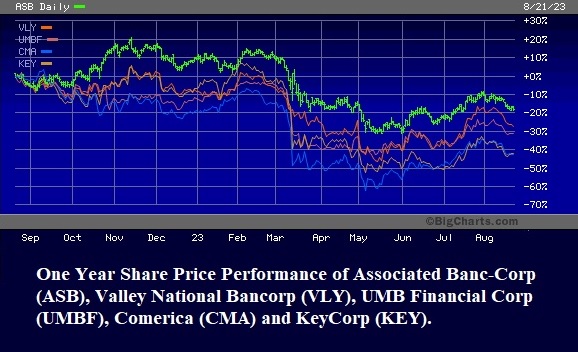By Pam Martens and Russ Martens: August 22, 2023 ~
The stock prices of KeyCorp and Comerica had already lost more than 40 percent of their market value over the past year through the closing bell on Monday. KeyCorp was sporting a depressed share price of $10.89 at the close yesterday after trading in the single digits during the banking crisis in March. Then S&P Global delivered more bad news yesterday. It downgraded the credit rating on both KeyCorp and Comerica by one notch. Outlooks were indicated as “stable” for both banks by S&P.
Three other banks were also downgraded by one notch yesterday by S&P: Valley National Bancorp, UMB Financial Corp. and Associated Banc-Corp.
S&P lowered outlooks on two other banks to negative: River City Bank and S&T Bank.
The ratings action on KeyCorp is particularly noteworthy. According to the Federal Reserve, as of June 30 KeyCorp had $193 billion in consolidated assets and ranked as the 20th largest bank in the United States. (That compares to consolidated assets at Comerica of $91 billion; Valley National Bancorp at $62 billion; Associated Banc-Corp and UMB Financial Corp. at $41 billion each.)
S&P cited the following as its concerns specific to KeyCorp:
“We believe that interest rate risk management amid higher-for-longer rates will constrain profitability at KeyCorp more than at large regional bank peers.
“In addition, the bank’s capital ratios — including its Tier 1 risk-based capital ratio inclusive of unrealized losses on available-for-sale securities — are at the low end of the peer average.
“We lowered our long-term ratings on KeyCorp to ‘BBB’ from ‘BBB+’ and those on its bank to ‘BBB+’ from ‘A-‘.
“The stable outlook on KeyCorp reflects our view that — at the current rating level — the company is well positioned to absorb tougher operating conditions for regional banks, which we think may pressure KeyCorp’s profitability and funding profile before gradually abating over the next two years.”
Another persistent concern in market pricing of bank stocks is that as interest rates rise, banks have to compete harder for deposits by raising the interest rates they pay on their CDs, money market accounts, and savings deposits. This puts strains on their profitability. Since April 13, 2022, there has been the largest upheaval in the movement of deposits in the past four decades. (See Related Articles below.)
Another competitor to bank deposits has been the surging yields on U.S. Treasury securities. As we reported in May, Americans Stampeded into TreasuryDirect Last Year, Opening Almost 3 Million New Accounts to Capture Rising Yields on Savings Bonds and Treasurys.
As of this morning, the 3-month T-Bill is yielding 5.43 percent; the 6-month T-Bill is yielding 5.48 percent; the two-year Treasury Note is yielding 5.01 percent; while the 10-year Treasury Note is yielding 4.34 percent.
S&P’s credit downgrades yesterday followed sweeping bank credit downgrades two weeks ago by Moody’s on August 7. (See our report: Moody’s Cuts Credit Ratings on 10 Banks; Places 4 of the 15 Largest Banks in U.S. on Review for Possible Downgrade.) On March 13, Moody’s had downgraded its outlook for the entire U.S. banking system following the abrupt failures of Silicon Valley Bank and Signature Bank, which demonstrated how rapidly deposits can exit a bank in the digital age.
On August 15, the Dow tumbled 361 points on news from a Fitch analyst in an interview at CNBC that even the largest banks, such as JPMorgan Chase, were at risk of a downgrade.
Related Articles:
Wall Street’s Casino Banks, Taking Deposits from Savers, in 1929 and Today


